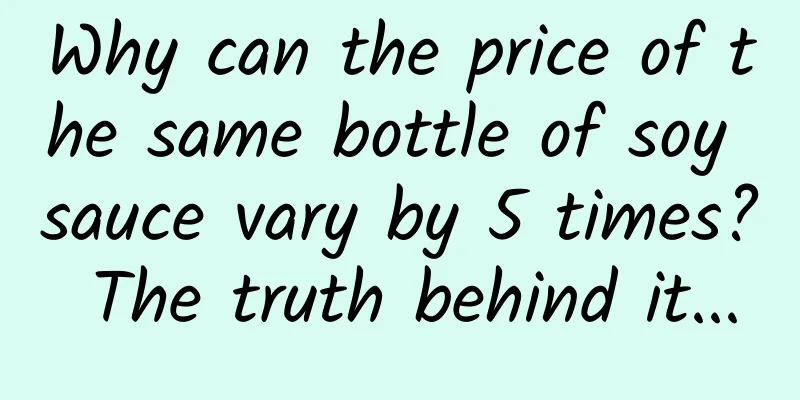Why can the price of the same bottle of soy sauce vary by 5 times? The truth behind it...

|
When it comes to soy sauce, I believe everyone is familiar with it. It is an indispensable part of people's daily life. However, when you buy soy sauce, you will find that the price difference is surprisingly large, ranging from a few yuan a bottle to several hundred yuan a bottle. What are the differences between these soy sauces? Today, we will reveal the secrets behind the prices of soy sauces. Image source: Screenshot of e-commerce platform How is soy sauce made? As early as the Zhou Dynasty more than 3,000 years ago, there were clear records about making soy sauce. In the "Book of Songs·Da Ya·Xing Wei", there is a sentence "醯醢以荐, 燔或烤", in which "醢" (pronounced hǎi) refers to the prototype of soy sauce. At that time, soy sauce was made from fresh meat pickled, and its unique flavor was endless. It gradually spread from the palace to the people and was loved by the general public. As time went by, the wise working people found that soy sauce made from soybeans not only had a similar flavor to fresh meat soy sauce, but was also cheaper and easier to popularize. As a result, soybeans gradually replaced fresh meat and became the main raw material for soy sauce. This change not only reduced the production cost of soy sauce, but also made it closer to people's lives, becoming a must-have on the tables of thousands of households. There are two main fermentation methods for soy sauce today: high-salt dilute fermentation and low-salt solid fermentation. Among them, high-salt dilute fermentation is the mainstream fermentation method. According to GB/T 18186-2000, the national standard for brewing soy sauce, the production process of soy sauce is as follows: ● High-salt diluted fermented soy sauce ( including solid diluted fermented soy sauce ) Soy sauce is made from soybeans and/or defatted soybeans, wheat and/or wheat flour, which are steamed, koji-made with Aspergillus, mixed with salt water to form a dilute mash, and then fermented. ● Low-salt solid-state fermented soy sauce Soy sauce is made from defatted soybeans and wheat bran, which are steamed and fermented with Aspergillus koji, then mixed with salt water to form a solid mash, which is then fermented. High and low price soy sauce What is the difference? There is a big price gap between high-priced soy sauce and low-priced soy sauce. Is there really a big difference in quality and taste? High-priced soy sauce often has these three characteristics: 1 Zero Additive This is a representative of those who pursue a "clean" ingredient list. The ingredient list only contains basic ingredients such as water, soybeans, wheat and salt. Some products will add sugar to promote fermentation and adjust the taste. In this type of soy sauce, preservatives, sweeteners and MSG are often brought up as issues, and they will label that they do not add these ingredients. Source: Details page of a high-priced brand e-commerce From the ingredient list of soy sauce, we can see that as the price gets lower and lower, the types of additives increase and the ingredients become more and more complicated. Source: Ingredients list of 40 soy sauces 2 organic Some high-priced soy sauce brands use organic raw materials, so such soy sauce is naturally expensive. This is because the production of such soy sauce raw materials must follow strict standards and specifications, and cannot use pesticides, fertilizers and other synthetic substances. Instead, organic fertilizers and manual pest control are used as substitutes, which are more expensive than ordinary raw materials. In addition, the annual organic certification fee and the market law that scarcity makes things more expensive all determine the high price of organic soy sauce. Source: Product details page of an organic soy sauce Lower-priced soy sauces may compromise on raw materials, using more common soybeans or adding other substitutes to reduce production costs. Source: Ingredients list of a relatively low-priced soy sauce 3 Salt reduction "Reduced salt", "light salt", "low salt"... These soy sauces that claim to contain less salt are more expensive among products of the same brand. Taking a certain brand as an example, the price of reduced-salt soy sauce is about twice as high as that of ordinary soy sauce with the same ingredients and grade. So, why is soy sauce made with reduced salt technology more expensive than ordinary soy sauce? On the one hand, during the production process of reduced-salt soy sauce, special technical means are required to reduce the salt content while ensuring that the taste and quality of the product are not affected. This involves complex production processes and fine control, and may require more advanced production equipment, more precise process control, and higher-quality raw materials. On the other hand, some high-end brands or brands that focus on healthy eating may use reduced-salt soy sauce as their specialty products and reflect its quality and value through pricing. These brands usually invest more resources in marketing and brand building, thereby increasing the added value and market price of their products. In general, the reason why soy sauce produced with reduced-salt process is more expensive than ordinary soy sauce is mainly due to the complexity of its production process, the market demand for its health attributes , and the combined effect of factors such as brand and market positioning. Of course, in addition to the above three characteristics, "first draw" and "ancient traditional craftsmanship" are also selling points for the high price. Choosing a good soy sauce Remember these 3 steps Regardless of whether it is "organic", "first-class", or "traditional", when buying soy sauce, you still need to use data to speak. Remember these 3 steps to help you quickly identify good soy sauce from many soy sauces. 1 Choose according to usage There are many types of soy sauce on the market, the most common categories are light soy sauce and dark soy sauce. ● For salad dressing or dipping, choose light soy sauce Light soy sauce is a basic type of soy sauce that enhances the flavor of cooking. It is light in color and fresh in taste, and will not steal the limelight from cold dishes. For example, if you mix cucumbers, add a few drops of light soy sauce to instantly enhance the taste. ● Choose dark soy sauce for cooking and stewing Dark soy sauce is a thick soy sauce made by adding caramel to light soy sauce through a special process. It is dark in color, viscous, and has a strong aroma. It is mainly used to color dishes such as braised dishes, stews, and marinated foods. Imagine the braised pork with dark soy sauce, which is bright red and extremely tempting! In addition to light soy sauce and dark soy sauce, there are some special soy sauces on the market. For example, seafood soy sauce for cooking seafood, steamed fish soy sauce for steaming fish to remove the fishy smell, sushi soy sauce specially used for dipping sushi and sashimi... Therefore, when choosing soy sauce, we should choose the appropriate variety according to our cooking needs. 2 Choose "fresh" After comparing many types of soy sauce, I discovered a secret that is often overlooked by the public: amino acid nitrogen . Amino acid nitrogen is an important indicator for measuring the umami taste of soy sauce and is also one of the criteria for grading soy sauce. The higher its content, the richer the amino acid content in the soy sauce and the better the umami taste. Source: GB 18186-2000 Brewed Soy Sauce Amino acid nitrogen is generally a flavor substance formed by the decomposition of protein during brewing, but some products will add extra sodium glutamate to soy sauce in order to increase the content of amino acid nitrogen. You will see that some soy sauces of average quality and low price have a high content of amino acid nitrogen. Source: Ingredients list of a certain soy sauce Take this one for example. The raw soybean content is not as much as the salt added, so the amino acid nitrogen of this soy sauce is naturally not high. However, this is a premium soy sauce, with an amino acid nitrogen content of more than 1.2 (much higher than the 0.8 of premium soy sauce), which is entirely "thanks" to the addition of sodium glutamate, which effortlessly reaches the premium level. Therefore, ingredients with high amino acid nitrogen and no other proteins/amino acids are the "right way". In other words, if the product does not contain any amino acid ingredients such as sodium glutamate, and the high amino acid nitrogen content comes entirely from soybeans and good production processes, then it is considered a "genuine" good soy sauce and is "really fresh." For example, this product has simple ingredients, and all the amino acid nitrogen comes from soybeans and other raw materials. Source: Ingredients list of a certain soy sauce 3 Choose low sodium In 2019, a study published in The Lancet, covering 195 countries and regions around the world, deeply analyzed the relationship between dietary habits and cancer incidence and mortality. my country ranks first in the world in mortality caused by excessive salt intake. According to the "Scientific Research Report on Chinese Residents' Dietary Guidelines (2021)", the prevalence of hypertension in my country has also increased year by year. Source: "Scientific Research Report on Chinese Dietary Guidelines (2021)" In recent years, people have paid more and more attention to salt intake, and "low-salt and low-sodium" products have gradually entered the public eye. At present, the common soy sauce on the market is basically high-salt diluted fermented soy sauce, and the sodium content of every 10g of soy sauce is between 600~800mg, that is, between 1.5~2g. The Chinese Nutrition Society recommends that the daily salt intake should not exceed 5g. In other words, a spoonful of soy sauce basically accounts for 30%~40% of the recommended daily salt intake. Sodium content is also a factor to consider when choosing soy sauce. When choosing soy sauce, we should pay attention to the sodium content and try to choose low-sodium or reduced-salt products. At the same time, we should also be careful not to use soy sauce as salt to avoid excessive sodium intake. In addition, there is another point that needs special attention. Although many people choose low-salt soy sauce, they will put 2 to 3 spoons instead of one spoonful, which leads to an increase in the total sodium intake. This is not worth the loss. Choosing low-sodium soy sauce is to reduce the total sodium intake. There is no consensus on how low the sodium content in soy sauce is. According to the current soy sauce market, when choosing soy sauce, the sodium content should not exceed 500 mg per 10 g, or 750 mg per 15 g. Source: Ingredients list of a certain soy sauce In addition to the above 3 steps, it is also more worthwhile to buy products with pure ingredients, glass bottle packaging, and good opening seal. When buying, everyone can choose according to their own needs. Soy Sauce for Science Pay attention to these points 1 It is best not to exceed 1 spoon per dish Although soy sauce can add flavor to food, excessive use may make the food too salty, affecting the taste and health. When cooking, we should add soy sauce in moderation and avoid excessive amounts. It is best not to use more than 1 spoon of soy sauce per dish. For example, a white porcelain spoon of soy sauce in my house is 11.2g, which is about 1.7-2.3g of salt, equivalent to 34%-46% of the recommended daily salt intake for one person. Image source: Photographed by the author 2 Flexibly adjust the time of adding soy sauce Different cooking methods require different times to use soy sauce. For example, in dishes that require a long cooking time, such as stewing and braising, soy sauce can be added earlier to allow it to fully penetrate the ingredients and enhance the flavor of the dish. In cooking methods such as stir-frying and cold salad, it is recommended to add soy sauce just before the ingredients are served, so as to maintain the freshness of the soy sauce and avoid high temperatures from destroying its nutrients. 3 Low-salt soy sauce without preservatives should be kept in the refrigerator Some soy sauces have preservatives added, while others do not. Since soy sauce is fermented from soybeans, zero-additive and reduced-salt soy sauces lack preservatives and high osmotic pressure to inhibit bacteria, and are prone to mold and hair growth at room temperature. Source: Ingredients list of a certain soy sauce For opened soy sauce, it is best to store it in the refrigerator to extend its shelf life. At the same time, after using the soy sauce, tighten the bottle cap in time to prevent air from entering and causing oxidation of the soy sauce. References [1] The global, regional, and national burden of stomach cancer in 195 countries, 1990–2017: a systematic analysis for the Global Burden of Disease study 2017. The Lancet Gastroenterology & Hepatology.DOI: https://doi.org/10.1016/S2468-1253(19)30328-0 [2] GB/T 18186-2000 Brewed soy sauce [3] GB 2717-2018 National Food Safety Standard for Soy Sauce [4] Chinese Nutrition Society. Scientific Research Report on Dietary Guidelines for Chinese Residents (2021) [5] Chinese Nutrition Society. Dietary Guidelines for Chinese Residents (2022) [6] Wikipedia. Soy sauce Planning and production Author: Li Chun, registered nutritionist Review | Ruan Guangfeng, Deputy Director of Kexin Food and Health Information Exchange Center Planning丨Zhong Yanping Editor: Zhong Yanping Proofread by Xu Lailinlin The cover image and the images in this article are from the copyright library Reprinting may lead to copyright disputes |
>>: Is it better to eat beans than meat? Plant protein or animal protein, which one do you prefer?
Recommend
Apple App Store data report: Why do taxi apps frequently fail to appear on the list?
It has been more than a week since the Didi Chuxi...
The most comprehensive guide to information flow advertising, everything you want to know is here!
Advertising in the new media era is truly pervasi...
Amateur experts help Apple with design: How to make the notification bar in iOS 11 more useful?
Editor's note: Love is the root of all evil. ...
Do pregnant mules die? Why can't mules give birth? The culprit is...
Expert of this article: Zhao Xumao, Young Researc...
Is it better to sleep with the window open or with the air conditioner on when it's hot? The doctor's answer is surprising
In the hot summer nights, the temperature is so h...
Practical notes on Kuaishou, Douyin, and Video Account
Today I will continue to share with you my learni...
Perfect Diary’s offline promotion method!
Perfect Diary is one of the brands that researche...
Written after DeepSeek became popular: AI is developing so fast, will it develop faster and faster in the future?
Produced by: Science Popularization China Author:...
5.5-inch iPhone 6 is not available even if you have money
iPhone 6 and iPhone 6 Plus will soon be launched ...
8 tips for achieving the best advertising results with a limited budget!
Have you ever encountered this situation? You took...
If a tool app wants to transform, what should the operators do?
Meitu was cashed out by early-stage investment in...
Brother becomes sister? Official announcement: The gender of this chubby cat is actually... wrong!
January 24 A sudden news Topped the trending sear...
Apple will officially release iOS 16 tomorrow, and the update rate of iOS 15 has reached 89%
On June 6, according to foreign media reports, Ap...
Without a "chin" and "upper jaw", they are miserable.
The Cambrian period began 541 million years ago, ...









